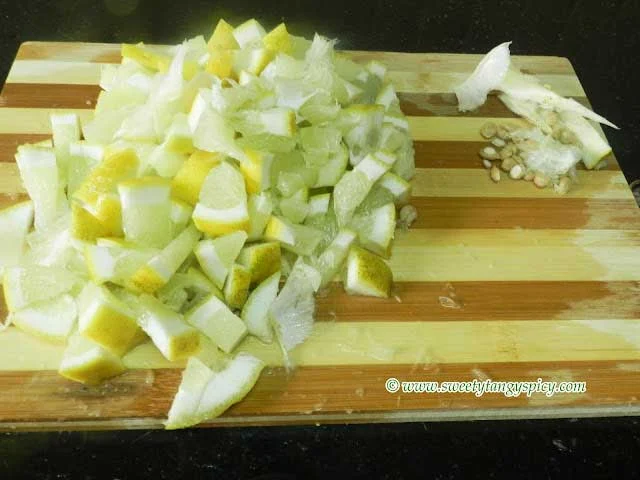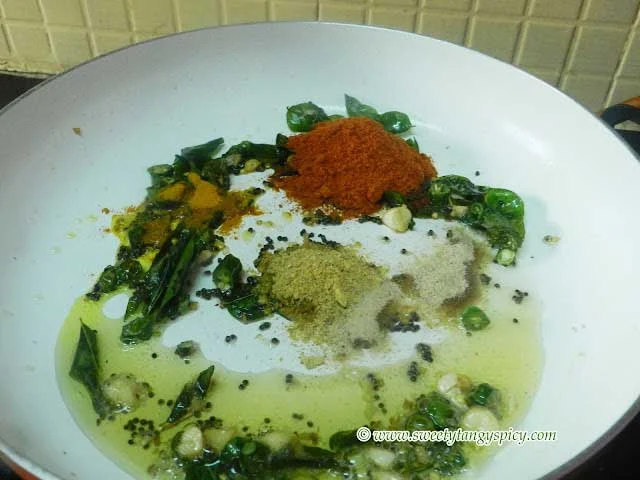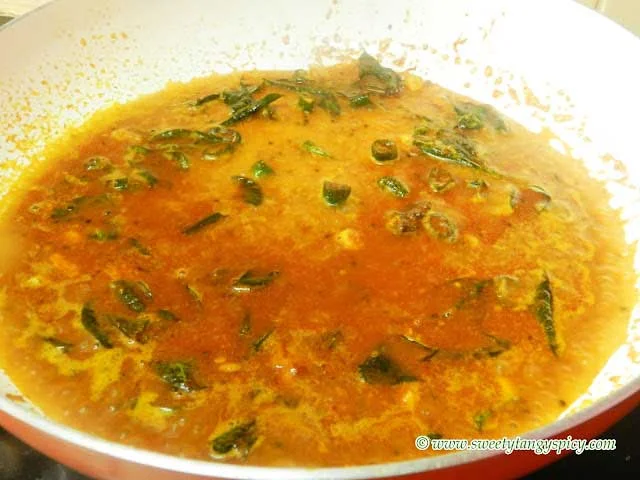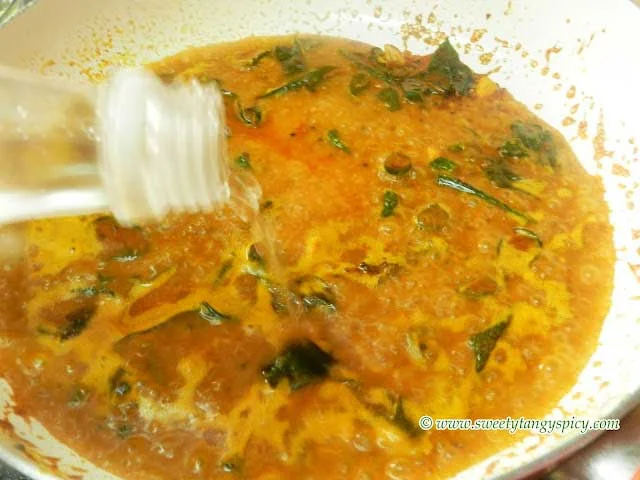Sadhya naranga curry | Vadaka Puli Naranga Curry | Naranga Achar | Wild Lime Pickle with detailed photos.
In the vibrant tapestry of Kerala's culinary tradition, Vadakapuli Naranga Achar, or Wild Lime Pickle, stands out as a cherished condiment that encapsulates the state's rich flavors and cultural heritage. This delectable pickle, crafted from wild limes or small sour oranges, is a testament to Kerala's culinary ingenuity and the art of preserving the vibrant tanginess of these unique citrus gems.
Vadakapuli Naranga Achar holds a special place in Kerala's gastronomy, not only for its mouthwatering taste but also for its versatility. It can transform the simplest of meals into a feast, adding a burst of zest and spiciness to each bite. Whether served with steaming rice, crispy dosas, fluffy idlis, or as an accompaniment to traditional Sadhya feasts, this pickle elevates the dining experience to a new level.
But Vadakapuli Naranga Achar is more than just a condiment; it's a reflection of Kerala's agrarian heritage and the resourcefulness of its people. The wild limes used in this pickle are often foraged from the bountiful landscapes of Kerala, connecting the dish to the region's lush greenery and fertile soil. This practice not only showcases the sustainable use of local ingredients but also imparts a unique flavor profile that can't be replicated with cultivated citrus.
In this culinary journey, we will explore the art of creating Vadakapuli Naranga Achar from scratch, uncovering the secrets of its preparation, and delving into the diverse regional variations that add a touch of individuality to this timeless recipe. We'll also touch upon the health benefits, cultural significance, and personal anecdotes associated with this pickle, providing you with a holistic understanding of why it holds a special place in Kerala's culinary heart.
So, let's embark on this flavorful voyage into the world of Vadakapuli Naranga Achar, where tradition, taste, and tanginess converge to create a truly unforgettable culinary experience.
Savoring Kerala's Tradition: Vadakapuli Naranga Achar - A Timeless Sadya Essential
Unveiling the Magic of Kerala's Irresistible Delight
Vadakapuli Naranga Achar, also known as Sadya Naranga Achar, isn't just a seasonal Onam treat; it's a year-round essential on Kerala's culinary stage. This quick-to-prepare pickle graces the Sadya table, making it an indispensable part of this grand feast. As time passes, its initial bitterness mellows, transforming into a harmonious symphony of spiciness, sweetness, and sourness that delights our taste buds.
The Star Ingredient: Vadakapuli (Wild Lime)
Central to this pickle's charm is the wild lime, fondly referred to as vadakapuli or curry naranga in Malayalam. Unlike the familiar lemon, this lime is larger and boasts a similar zesty flavor profile. Its invigorating lemony fragrance and a touch of bitterness make it the ideal candidate for crafting pickles and side dishes. Vadakapuli naranga achar exemplifies the art of turning this unique citrus gem into a culinary masterpiece.
Beyond a Pickle: The Essence of Naranga Curry
While it shares ingredients with traditional pickles, vadakapuli naranga achar transcends the conventional. It's more than a pickle; it's a side dish, earning the distinguished title of "naranga curry." This distinction underscores its role as an indispensable component of the rich tapestry of flavors that compose a Kerala Sadya.
A Limited Shelf Life with Time-Enhanced Flavor
Unlike many other Kerala pickles, vadakapuli naranga achar boasts a shorter shelf life. However, there's no need to fret. Storing it in the refrigerator for up to a month won't significantly alter its taste and aroma. Over time, the bitterness may subside, but the intricate blend of flavors remains steadfast.
As you savor vadakapuli naranga achar, you embrace a culinary tradition that extends well beyond the confines of a festival. It's a taste of Kerala's heart and soul, reflecting the diversity, harmony, and irresistible allure of its cuisine. Whether it graces your Onam Sadya or any meal, this pickle is a testament to Kerala's culinary excellence.
Mastering Vadakapuli Naranga Achar: Expert Tips and Best Practices
As you embark on your journey to create the perfect Vadakapuli Naranga Achar, consider these expert tips and best practices to elevate your culinary prowess:
1. Choose Fresh Wild Limes: Start with the foundation of flavor by selecting ripe and unblemished wild limes. Look for vibrant green limes with a firm texture, as their quality significantly impacts the final taste.
2. Properly Wash and Dry: Before you begin, ensure your wild limes are thoroughly washed and dried. Any moisture can affect the pickle's shelf life, so take extra care to keep them dry.
3. Seed Removal for Mildness: To reduce bitterness, remove both the seeds and inner white layers of the wild limes completely. However, never compromise the skin, as it plays a vital role in the pickle's texture.
4. The Art of Balance: Vadakapuli Naranga Achar offers a spectrum of flavors. Adjust the levels of spice, sweetness, and sourness to suit your personal taste. Consider adding sugar or jaggery to achieve the ideal balance.
5. Use Boiled and Cooled Water: To extend the pickle's shelf life and ensure freshness, use boiled and cooled water during preparation. This practice helps preserve its vibrant flavors.
6. Secure Storage: When it's time to store your Vadakapuli Naranga Achar, opt for a clean, airtight glass jar. Ensure that the pickle is fully submerged in oil to maintain its rich flavor.
7. Patience in Maturation: Allow the pickle to mature for a few days before indulging. This crucial step lets the flavors harmonize and intensify, resulting in a taste that truly captures Kerala's essence.
8. Enjoy the Culinary Heritage: Vadakapuli Naranga Achar isn't just a condiment; it's a culinary journey through Kerala's diverse traditions. Share it with loved ones and celebrate the vibrant tapestry of Kerala's cuisine.
These expert tips, combined with the previously mentioned insights, will empower you to create a Vadakapuli Naranga Achar that showcases the true essence of Kerala's culinary brilliance. Whether it graces your Onam Sadya or any meal, this pickle is a testament to Kerala's gastronomic excellence. Embrace the flavors, cherish the tradition, and savor every bite of this delightful culinary masterpiece.
Proper Storage of Naranga Curry: Preserving Kerala's Tangy Treasure
Nurturing the Flavor for the Long Haul
To ensure that your Vadakapuli Naranga Curry maintains its vibrant taste and aroma, it's essential to store it correctly. Here are some guidelines for storing this Kerala delicacy:
1. Airtight Container: Transfer the Vadakapuli Naranga Curry into a clean, airtight container with a secure lid. Make sure there is minimal air trapped inside, as exposure to air can lead to spoilage.
2. Refrigeration: Refrigeration is key to preserving the freshness of Vadakapuli Naranga Curry. Store the sealed container in the refrigerator at all times.
3. Use Clean Utensils: Always use clean and dry utensils when serving the curry. Moisture or contaminants can affect its shelf life.
4. Check for Spoilage: Periodically inspect the curry for any signs of spoilage, such as unusual odors, mold growth, or changes in color or texture. If you detect any of these signs, it's best to discard the curry.
5. Consume Promptly: While Vadakapuli Naranga Curry can be stored in the refrigerator for a reasonable period, it's advisable to consume it within a reasonable time frame to enjoy its peak flavor.
By following these storage tips, you can relish the delightful flavors of Naranga Curry, preserving its essence and savoring the taste of Kerala's culinary heritage for an extended period. Whether it's a part of your daily meal or a special occasion, the correct storage ensures that the tangy treasure of Kerala remains at its best.
Preparing Vadakapuli Naranga Curry: A Step-by-Step Guide
Step 1: Preparing the Naranga (Lime)
Step 2: Adding Salt and Mixing
In the second step of preparing your flavorful Vadakapuli Naranga Curry, it's time to add the essential seasoning and create a well-balanced taste profile. Here's how to do it:
1. Season with Salt: Begin by adding salt to taste to the freshly chopped naranga pieces. The amount of salt may vary depending on your preference and the quantity of naranga you're using. Start with a moderate amount and adjust according to your taste.
2. Mix Thoroughly: After adding the salt, carefully mix the chopped naranga pieces to ensure that the salt is evenly distributed. This step is crucial for achieving a harmonious blend of flavors.
3. Set Aside: Once the salt is well incorporated, set the seasoned naranga aside for a brief period. Allowing the naranga to marinate with the salt will enhance its taste and help meld the flavors together.
With this step complete, you're one step closer to savoring the delightful Naranga Curry, a true Kerala culinary gem.
Step 3: Tempering with Mustard Seeds
In the third step of preparing your aromatic Vadakapuli Naranga Curry, we introduce the rich flavor of mustard seeds through the process of tempering. Here's how to do it:
1. Heat Gingelly Oil: Start by heating gingelly oil in a thick-bottomed pan over medium heat. Gingelly oil, with its distinct nutty flavor, is a common choice in Kerala cuisine, adding authenticity to the dish.
2. Measure and Add Mustard Seeds: Once the oil is sufficiently heated, measure out 1 teaspoon of mustard seeds and add them to the hot oil. Allow the mustard seeds to sizzle and crackle in the oil.
3. Listen for the Crackling: As the mustard seeds heat up, they will release a delightful crackling sound. This is a sign that they are infusing the oil with their aromatic essence. It usually takes just a minute or so for the crackling to occur.
4. Remove from Heat: As soon as the mustard seeds have crackled and turned slightly golden, promptly remove the pan from the heat source. Be cautious not to overcook them, as burnt mustard seeds can impart a bitter taste.
This tempering process with mustard seeds and gingelly oil adds a depth of flavor to your Naranga Curry, elevating it to a Kerala culinary masterpiece. It's a crucial step that enhances the overall taste and aroma of the dish.
Step 4: Infusing Flavor with Curry Leaves, Garlic, Ginger, and Green Chilies
In this fourth step of creating your flavorful Naranga Curry, we add a burst of aromatic ingredients to elevate the dish. Here's how to do it:
1. Wait for Mustard Seeds to Crackle: As the mustard seeds sizzle and crackle in the gingelly oil, patiently wait for this delightful sound. It indicates that the mustard seeds have released their flavors into the oil.
2. Add Curry Leaves: Once the mustard seeds have crackled, add fresh curry leaves to the pan. Curry leaves are a staple in Kerala cuisine, known for their aromatic essence that infuses dishes with a distinct flavor.
3. Introduce Garlic, Ginger, and Green Chilies: Following the curry leaves, add finely chopped garlic cloves, ginger, and green chilies to the pan. These ingredients contribute to the complexity of flavors in the Vadakapuli Naranga Curry. Adjust the quantity of green chilies according to your desired level of spiciness.
4. Sauté to Release Aromas: Stir and sauté the mixture of curry leaves, garlic, ginger, and green chilies in the aromatic gingelly oil. Allow these ingredients to release their delightful aromas and flavors.
5. Sauté Until Fragrant: Continue sautéing for a few minutes, or until the garlic and ginger turn golden and fragrant. This step is crucial for developing the base flavors of the curry.
Step 5: Adding Spice Powders for Flavor and Color
In the fifth step of crafting your delectable Naranga Curry, we introduce a symphony of spices to infuse rich flavors and vibrant color into the dish. Here's how to do it:
1. Reduce the Flame or Switch Off: To avoid burning the spices, reduce the flame to its lowest setting or simply switch off the heat source. This step is crucial for preventing the spices from becoming bitter.
2. Add the Spice Powders: While the pan is still warm, add the following spice powders to the sautéed mixture:
- 3 teaspoons of red chili powder
- 3 teaspoons of Kashmiri chili powder (optional, for color)
- 1/2 teaspoon of turmeric powder
- 1/2 teaspoon of fenugreek powder
- 1/2 teaspoon of asafoetida
3. Stir to Combine: Gently stir the spice powders into the sautéed mixture, ensuring that they are evenly distributed. This will create a flavorful spice base for your Vadakapuli Naranga Curry.
4. Be Cautious with Heat: Since the heat source is off or at its lowest, there's no need to cook the spices extensively at this stage. The residual warmth of the pan will be sufficient to release their flavors.
This step introduces a medley of spices that will infuse your Vadakapuli Naranga Curry with a tantalizing blend of taste and color. The spices are a cornerstone of Kerala's culinary heritage, creating a harmonious symphony of flavors in this traditional dish.
Step 6: Adding Boiled Water and Bringing to a Boil
In the sixth step of preparing your Naranga Curry, we introduce water to create the curry's base and allow it to come to a rolling boil. Here's how to proceed:
1. Add Boiled Water: Immediately pour in 1/2 cup of boiled water into the pan, which contains the sautéed spice mixture. The boiled water helps blend the spices and create the flavorful curry base.
2. Increase the Flame to High: Turn up the heat to high flame to bring the mixture to a vigorous boil. Boiling will further infuse the spices into the water, creating a fragrant and flavorful curry.
3. Stir Occasionally: While the mixture boils, stir it occasionally to ensure that the spices are well incorporated into the water. This step is crucial for achieving a consistent and aromatic curry.
Bringing the mixture to a boil is a pivotal step in creating the base for your Naranga Curry. The boiling process allows the spices to meld with the water, resulting in a curry that's bursting with the authentic flavors of Kerala.
Step 7: Adding Vinegar for Tanginess
In the seventh step of creating your Naranga Curry, we introduce vinegar to infuse the dish with a delightful tangy flavor. Here's how to proceed:
1. Measure the Vinegar: Begin by measuring the required amount of vinegar as per your recipe. The vinegar's tangy acidity is a key component of Naranga Curry's unique taste.
2. Pour the Vinegar: Carefully pour the measured vinegar into the boiling curry base. The vinegar will contribute a refreshing tanginess that complements the spices and naranga beautifully.
3. Stir to Combine: Gently stir the vinegar into the curry base to ensure that it is evenly distributed. This step is essential for achieving a harmonious blend of flavors.
The addition of vinegar in this step elevates your Naranga Curry, imparting the distinctive tangy twist that is characteristic of Kerala's culinary tradition. It's a pivotal moment that enhances the overall taste profile of the dish.
Step 8: Infusing Sweetness with Sugar
In the eighth step of crafting your Vadakapuli Naranga Curry, we introduce sugar to balance the flavors and create a harmonious blend of sweet and tangy notes. Here's how to proceed:
1. Add the Sugar: Sprinkle sugar into the simmering curry. The sugar will gradually melt into the mixture, infusing it with a pleasant sweetness.
2. Wait for the Sugar to Melt: Allow the sugar to melt naturally in the curry as it continues to simmer. Stir occasionally to aid the melting process.
Adding sugar at this stage is a crucial step for achieving the balanced and nuanced flavor profile of Naranga Curry. The sweetness contrasts and harmonizes with the tanginess, creating a delightful symphony of tastes that Kerala cuisine is known for.
Step 9: Adding Prepared Naranga (Lime) and Cooking
In the ninth step of creating your Vadakapuli Naranga Curry, we introduce the prepared naranga (lime) pieces into the curry and allow them to cook gently until they become tender. Here's how to proceed:
1. Add the Prepared Naranga: Carefully add the previously prepared naranga (lime) pieces to the simmering curry. These lime pieces will absorb the rich flavors of the curry and become tender as they cook.
2. Cover and Cook on Low Flame: Once the naranga pieces are added, cover the pan with a lid. Reduce the heat to a low flame to ensure gentle cooking. This slow cooking process allows the naranga to soften while absorbing the delicious flavors of the curry.
3. Monitor and Stir: Periodically check and stir the curry while it cooks. Ensure that the naranga pieces are evenly coated with the curry sauce and are tender to the bite.
Cooking the prepared naranga in the curry is the final step that brings all the flavors together. This slow, covered cooking process allows the naranga to absorb the essence of the curry, resulting in a delectable dish that captures the essence of Kerala's culinary heritage.
Step 10: Taste Testing and Final Cooking
In the tenth and final step of perfecting your Vadakapuli Naranga Curry, we perform a crucial taste test to adjust the salt and sugar levels to your liking. Additionally, we aim to achieve the desired consistency for the gravy. Here's how to proceed:
1. Taste Test: Using a clean spoon, take a small sample of the curry, including a piece of naranga. Taste the curry and assess its flavors. Since the exact amount of salt and sugar can vary depending on the sourness of the naranga, this step allows you to customize the taste to your preference.
2. Adjust Salt and Sugar: Based on your taste test, adjust the salt and sugar levels as needed. If the curry is too sour, you can add a bit more sugar to balance it. If it needs more saltiness, sprinkle in a pinch of salt. Stir well to incorporate any adjustments.
3. Continue Cooking: Once you've fine-tuned the flavors, continue cooking the curry on a low flame. Allow it to simmer gently until the gravy thickens and reaches a semi-gravy consistency. This may take some time, so be patient.
4. Stir Occasionally: During this final cooking stage, stir the curry occasionally to prevent it from sticking to the pan and to ensure that the flavors meld together beautifully.
The taste test and adjustment of salt and sugar are the finishing touches that make your Vadakapuli Naranga Curry truly exceptional. It's a step that allows you to tailor the dish to your taste preferences, resulting in a curry that's perfectly balanced and full of flavor. Once the gravy achieves the desired consistency, your Vadakapuli Naranga Curry is ready to be served and enjoyed.
Maturing Your Vadakapuli Naranga Curry: A Flavor Transformation
Unlocking the Full Spectrum of Taste
After all the careful preparation and cooking, your Vadakapuli Naranga Curry is ready for its final transformation—a maturation process that takes it from a tangy creation to a well-balanced, flavor-packed delight.
1. Transfer to a Glass Container: Once your Vadakapuli Naranga Curry has cooled down completely, it's time to transfer it into a dry glass container. Using glass containers is ideal for preserving the flavors and aroma of the curry without any interference from other materials.
2. Initial Tanginess: At this stage, your freshly prepared Vadakapuli Naranga Curry will likely have a pronounced sour taste due to the naranga's natural acidity. This initial tanginess is characteristic of the pickle and sets the stage for the flavor journey to come.
3. Refrigerate for One Week: Place the sealed glass container of Vadakapuli Naranga Curry in your refrigerator, and let it rest untouched for about one week. This crucial resting period allows the flavors to evolve and mature.
4. Transformation Over Time: As the days pass, you'll notice a remarkable transformation. The initial sharp sourness will gradually mellow out, giving way to a harmonious blend of sweet, sour, tangy, and spicy notes. This evolution of flavors is the hallmark of a well-aged Vadakapuli Naranga Curry.
5. The Ultimate Taste: After this maturation period, your Vadakapuli Naranga Curry will have reached its full potential, offering a symphony of flavors that capture the essence of Kerala's culinary tradition. It's during this time that the true magic happens, and the pickle becomes a cherished delicacy.
Share Your Experience: We invite you to try this process and experience the remarkable journey of flavor transformation for yourself. We'd love to hear about your culinary adventures and how your Vadakapuli Naranga Curry turned out. If you have any questions or need guidance, please don't hesitate to reach out to us in the comments section below. Your feedback and experiences are a testament to the rich tapestry of Kerala's cuisine. Enjoy your pickle journey!
Pickled Wild Lime

Tangy Delight!
Preparation time: 15 minutes | Cooking time: 10 minutes | Total time: 25 minutes
Ingredients:
- 1 vadakapuli naranga / wild lime
- 3 green chilies, chopped
- 1 small bulb of garlic, peeled and chopped
- 1" piece ginger
- 3 teaspoons chili powder
- 3 teaspoons Kashmiri chili powder (optional, for color)
- 1/4 teaspoon turmeric powder
- 1/2 teaspoon fenugreek powder
- 1/2 teaspoon asafoetida powder
- 3 tablespoons vinegar
- 2 tablespoons sugar
- Salt, as needed
- 3 sprigs of curry leaves
- 1 teaspoon mustard seeds
- 1/4 cup gingelly oil or sesame oil (നല്ലെണ്ണ)
Instructions:
- Rinse and thoroughly dry the wild lime. Remove seeds and inner white layers, but retain the skin. Chop the lime into small pieces.
- In a thick-bottomed pan, heat the gingelly oil over medium heat. Add mustard seeds and wait until they crackle.
- Reduce the heat to low and add chopped green chilies, garlic, ginger, and curry leaves. Sauté until fragrant.
- Add chili powder, Kashmiri chili powder (if using), turmeric powder, fenugreek powder, and asafoetida powder. Stir to combine.
- Remove the pan from heat and let it cool slightly. Then, add vinegar, sugar, and salt. Adjust salt and sugar levels to taste.
- Transfer the prepared wild lime pieces into the pan and mix well.
- Return the pan to low heat and cook, covered, until the wild lime pieces become soft.
- Perform a taste test and adjust salt and sugar levels if needed. Continue cooking until the gravy thickens to a semi-gravy consistency.
- Allow the pickle to cool completely.
- Store the pickled wild lime in an airtight glass container. Refrigerate for about a week to allow the flavors to mature.


















0 Comments